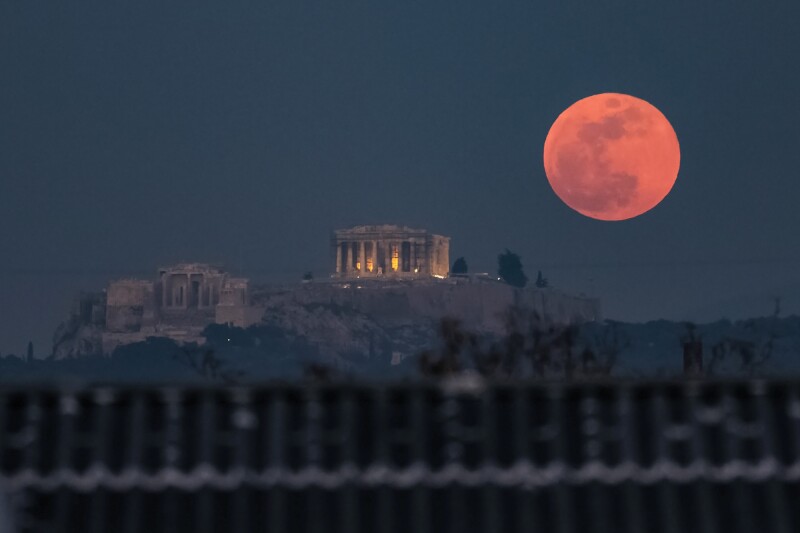Meteor showers are magical, but the sky can be fickle: Though you can check the moon coverage ahead of time, you never know if the night will be clear.
For the best chance of seeing any celestial event, you’ll need to go somewhere with little to no light pollution and, ideally, really dark skies. If you’re planning a trip around catching a meteor shower or lunar eclipse, staying in or near a Dark Sky Place ensures that, even if it’s cloudy, you’ll still see some stars. DarkSky International is an organization that certifies and helps conserve dark places—parks, nature reserves, communities, and even hotels, such as the Under Canvas glamping retreat in Lake Powell, Utah.
As for where to watch celestial events, the Pacific Northwest is particularly lucky; the Oregon Outback International Dark Sky Sanctuary is the largest in the world. But if a trip abroad is in the cards, you’ll find incredible stargazing around the globe, from Wadi Rum in Jordan to Sagarmatha National Park in Nepal, also a UNESCO World Heritage Site.
Geminids Meteor Shower
December 13–14, 2024
The Geminids peak this year on the night of December 13 and into the early hours of December 14 (it will be around the same date in 2025). Unfortunately, this particularly bright meteor shower—with 100 to 120 meteors per hour—will be dimmed by the moon being 97 percent full on the peak night, according to the American Meteor Organization. If you still want to plan a trip, you can see them in the Northern Hemisphere as early as 10 p.m. on December 13. In the Southern Hemisphere, you’ll have to wait until the middle of the night for the best viewing (but at least it’ll be warmer there).
Quadrantids Meteor Shower
January 2–3, 2025
Keep the New Year celebrations going with this meteor shower, which will peak the night of January 2 around 7 p.m. UTC. The moon will only be at 11 percent full and set before the shower begins in earnest, making for a nice, dark canvas for any meteors. You can see this meteor shower from anywhere in the Northern Hemisphere that has clear skies and little light pollution.

A super blood moon rises behind the Parthenon in Athens on January 31, 2018.
Photo by Kostas Koutsaftikis / Shutterstock.com
Blood Moon
March 13–14, 2025
A blood moon is another name for a total lunar eclipse that creates a red hue (hence the “blood”). According to the Farmers’ Almanac, this total eclipse will begin at 2:25 a.m. EDT and last for an hour and seven minutes, during which the moon will be at its reddest. The full eclipse will be visible in all of North America and most of South America; NASA has a map of exactly where and in what stages you’ll be able to see this most stunning of moons.
Another total lunar eclipse will take place on September 7, 2025, and this time you’ll be able to see it everywhere except in North and South America.
Lyrid Meteor Shower
April 15–29, 2025
EarthSky reports that the Lyrids will peak from late evening on April 21 until dawn on April 22, with the American Meteorological Society adding that you may even be able to catch some meteors until dawn on April 25. The peak coincides with a thick waning crescent moon that’s still 40 percent full, so to see the Lyrids, you’ll need really clear skies somewhere with no light pollution.

The 2018 Perseid meteor shower showing off.
Photo by Michał Mancewicz on Unsplash
Perseids Meteor Shower
August 12–13, 2025
The Perseids are typically the best meteor shower of the year due to their high rate (50 to 75 per hour) and the warm summer weather in the Northern Hemisphere that makes being outside a pleasure. According to EarthSky and the American Meteorological Society, the peak is predicted for 8 p.m. UTC on August 12; they’re best viewed from midnight to dawn, so you’ll have a decent amount of time to try and catch them. The moon will be a 91 percent full waning gibbous, but since Perseids tend to be bright, you’ll likely still see these meteors if you can block out the moon.
This article was originally published in 2019 and most recently updated on October 4, 2024 with current information. Sophie Friedman contributed to the reporting of this story.











